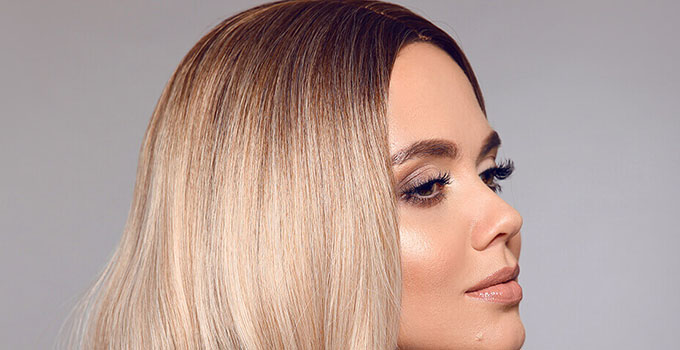New! Face Sunscreen SPF 50 with 15% introductory discount.

Ombre hair
Ombre hair; in French, ombre means 'shade'. Ombre is a term used in the world of hair dyeing when the top part of the hair is a different colour from the bottom part. In the case of an ombre, the top is darker and so the lengths are lighter.
Usually, the transition in colour is between eye level and chin level. There is no tight separation between the two colours; the transition runs naturally. In some tufts, the lighter colour runs a little further up into the darker colour. The two colours are also often ton-sur-ton. That means they are the same colour shades, but in a darker and lighter colour. The colour heights are not very far apart, so no dark brown with platinum blonde, for example. It usually involves two to three-colour heights, lighter in the lengths.
Classic and reverse ombre effect
You mention a 'regular' or classic ombre when it involves a darker top and a lighter hair colour in the lengths. But the reverse also happens, i.e. lighter at the top and darker at the ends. This is therefore called a 'reverse' ombre.
How to create ombre hair?
An ombre effect is beautiful on people with longer hair. You don't have to place the transition in colour too high then. Your ombre will then be less likely to look like you have the outgrowth. The longer the hair, the lower the place where you can blend the colours. Many people choose a height somewhere between the eyes and jaw.
With ombre hair, the bottom is usually bleached. Blonde can be very damaging to your hair. Make sure you make a conscious choice in this. Use a professional product at home, being careful not to leave the product on longer than necessary. Or have it done by a good hairdresser. The disadvantage is that this generally costs €100.
Want to bleach your hair yourself at home with a professional product? Then use the WECOLOUR Bleach and Highlight Set. Use Colour Mask to protect your hair. You can simply add this product to your bleach (ratio 1:6) to minimise damage to your hair. After bleaching, of course, treat your beautiful ombre hair with lots of love and gentleness to keep your hair looking its best. Read how to do this in the blog 'Taking care of your hair is the best tip for beautiful hair'. Use good grooming and styling products, and take it easy with heat and heat tools. Keep blonde hair out of the sun and the chlorinated sea or pool as much as possible. A top product that you will really benefit from even after bleaching is Colour Mask. Use Colour Mask as a deep-acting, conditioning and moisturising hair mask after washing your hair on towel-dried hair.
How does it differ from balayage?
With balayage, your hair is also dyed in different colours. And this too is a term that comes from the French language. Balayer literally means sweeping. With this technique, your hair is dyed and bleached/highlighted in different colours of hair in small tufts where the colours flow into each other. So, here the different colours are next to each other, whereas with ombre the colour difference is more horizontal. In addition, balayage often consists of several colours. The difference with high- and lowlights in different colours is that with this technique you keep most of your own hair colour, with high- and lowlights mixed in. With balayage, your entire hair is actually dyed.
Conclusion
With WECOLOUR hair colour you can lighten undyed hair from colour level 5 by one to at most two colour levels. Do you use ash very light blonde (11.1)? Then you can lighten undyed hair a little more colour heights. So sometimes you can achieve an ombre effect with hair dye, but in most cases you will not be able to achieve the desired effect with hair dye. We then advise you to use a professional bleaching product that is as gentle as possible on your hair, or have your hair blonded in a good salon for really beautiful ombre hair.
